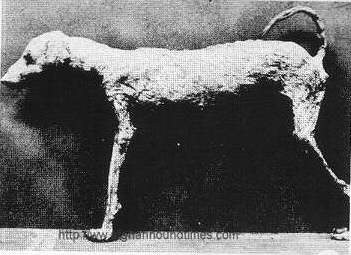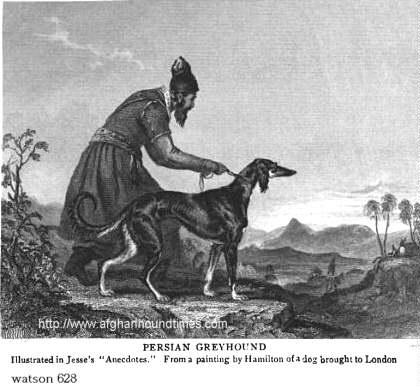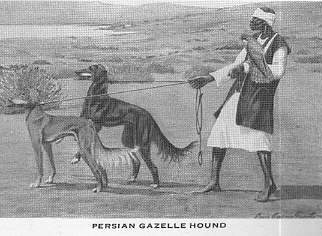(Afghan Hound Database and Breed Information Exchange)
Virginia Burch (El Kevir, USA) 1970'S With addtional notes/photos from Steve Tillotson 2011
We received the following article from a correspondent written by Virginia Burch (El Kevir, USA), for a breed magazine sometime in the 1970's "Considering the beautiful, silky-coated, show-dog, house-pet, the Afghan Hound has become today, it still comes as a surprise to the average man in the street that this breed is such a comparatively new one to the dog world. In going back through the old issues of the National Geographic Magazine, I have found several references to the Afghan Hound. In November 1912, in an article on Egyptology, there appears the above pictore of a mummified dog. From the bone structure it is assumed that this must have been a forerunner of the breed. Upon opening the tombs in the early part of this century, many diferent kinds of animals were disinterred. There were thousands of urns of birds alone. Many prick-eared dogs were found but only a few of the larger, ring-tailed, drop-eared hounds, and these were only in the tombs of the highest royalty.
The first mention of the word "Afghan" in any form is found in March 1919. It is intersting to note in this issue there is a description of the Persian Gazellehound, or Sloghi, and better than five years before either the Saluki or Afghan Hound made its presence felt in this country at all. The Geographic comments on the Saluki......nothing on the Afghan. However the reference to our breed in the description of the Saluki is interesting, "This ancient race (Saluki) is one of the most perculiar, most beautiful, and most puzzling of dgs. His graven image comes to us as one of the earliest of man's essays in art, and is so easily recognizable that there is no doubt possible as to the archaic artist's model. Possibly no known dog has changed less from our earliest knowledge of it to our present day The first perculiarity to strike the eye is the curious cokbination f close, short body hair, with silky flowing AFGHAN fleece on the ears and the long silken feathers from the stern. Otherwise he looks at first glance very much like a greyhound".
We wonder whre the term "Afghan Fleece" comes from. As for the description, it is much as we know of our own breed and its early foundations. In a now-defunct magazine, "The Mentor", in February 1927 all-rounder judge Louis. J. Muir, who is referred to as the "well-known Authority on Sporting Dogs and one of the three owners of Afghan Hounds in the United States", wrote an article on "The Kind Of Dog that Noah Knew".... It was in 1913 in the Quetta, Afghanistan, near northern India that Major and Mrs Bell-Murray and Miss Jean Manson first secured an Afghan Hound. They named her Begum, which means queen. it took four years to find another hound as fine as Begum were brought home to Scotland. A few years ago Major Bell-Murray made another visit to India and brought new blood into the well-established Cove Kennels of Scotland The Afghan Hound originally came from Afghanistan. There from time immemorial they have been owned only by the sheiks. Money cannot buy them. This is true to the present day. Records in the British Museum bear out Afghanistan tradition that this valiant beautiful sporting dog is the oldest domesticated breed in existance. In its native home it is believed to be one of the dogs that followed Noah into the Ark. Both the Afghan and Saluki hounds are affectionate, faithful to their masters and of good disposition. The afghan especially is marked by extreme intelligence and has extraordinarily keen scent. The Afghan Hound has been recognised by the English, American and Canadian Kennel Clubs......" In the National Geographic "Hound" issue of October 1937, in the article "Hark to the Hounds" by Freeman Lloyd, the Afghan is referred to: Unusually interesting are th Afghan Hound and the E gyptian Saluki - Greyhounds with setter-like or spaniel-like ears. Both are very old breeds, treasured favorites of kings and sheiks in their native lands where they were used for coursing gazelle. In the United Sates today there are many excellent specimens of both these exotic breeds. The Afghan which wears a coat of wool-like texture to suit the high altitudes of Afghanistan, is a favorite of motion-picture artists in Hollywood and its environs where its smart and unusual appearance is much admired". [Description of the Afghan Hound, same article.] - "A large, heavily coated dog of greyhound-like build, but with more powerful head, and feathered setter-like ears. The Afghan Hound is well fitted for the very cold winter climate of mountainous Afghanistan. The Afghan dog stands about 27 to 29 inches at the shoulder and weighs 60 pounds or more. He may roughly be described as an oversized Persian or Saluki Gazelle-Hound, but carrying much more hair on the flanks, hindquarters, ribs and forequarters, The hair is silky and very fine in texture, The feet are well-feathered and the head is surmounted by a topknot of long, fine hair. Altogether he is remarkable and striking in appearance and is gaining considerable poularity in Hollywood The forebears of the Afghan may have been the coursing dogs of the early Israelites and Egyptians. Records have been found indicating the existance of Afghan-like dogs on the Sinai Peninsula and in the Valley Of The Nile. The large feet of this dog are better suited for travelling over rocks than the smaller or catlike fot of other dogs used for sporting purposes in less mountanous countries than Afghanistan. When the first of the Afghan Hounds arrived in England they wre exhibited at a Kennel Show in the Crystal Palace, London. A party of Army officers who had seen service in Afghanistan appeared to be more interested in the feet of these hounds than in their other physical points Asking the reason for such an acute examination, the writer was informed that the hounds' broad hind feet were essentiasl to give added grip and climbing power; also that the toes should be arched as well as covered with long, thick hair. The Afghan Hound may be of any color" So here you have three opinions covering a span of eighteen years of the breed. Thirty-four more years and you still have basically the s ame dog. Thank God. We have taken them out of the hands of the film star. Of course, it it had not been for a few of these artists; Venita Varden Oakie, Charlie Ruggles, Harpo Marx, Mary Astor and Ginger Rogers to name a few owners, not to forget John Barrymore and his beloved Viola, we might not have had some of the dogs of today, as their desire to own something bizarre and their financial ability to procure same brought them before the public. My first glimpse of the breed was in 1939 when Jack and Venita Oakie descended from their car at a premiere at the Carhay Circle Theatre, walked - with two Afghans - the length of the red carpet to the door, handed the dogs back to their chauffer and entered the theatre. Very impressive". Note from Steve Tillotson - I have previously written on the topic of early writings on Afghan Hound origins click here for the relevant page. Related Content "Cove House" home of Bell Murray/Cove Afghan Hounds Origin Of The Afghan Hound Early Afghan Hounds Or Return to EARLY AFGHAN HOUNDS |


